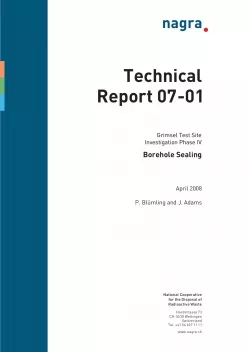
Technical Report NTB 07-01
Grimsel Test SiteInvestigation Phase IVBorehole Sealing
Within the context of the Phase IV (1994 - 1996) research and development activities at the Grimsel Test Site (GTS), Nagra developed, in collaboration with the Agence nationale pour la gestion des déchets radioactifs (Andra), an investigation project for the sealing of boreholes drilled from underground. The project had the following goals:
- Sealing of boreholes drilled from underground facilities with a length of up to 500 m
- Sealing of boreholes with mainly irregular shape (e.g. breakouts of borehole wall)
- Ensuring a hydraulic conductivity of 10-11 - 10-12 m/s for the seal
- Ensuring reliable quality control in routine production
Nagra’s new concept developed in this project was to use highly compacted bentonite pellets or granular bentonite while Andra evaluated the use of a cylindrical block of bentonite. This report deals with Nagra’s concepts only. The two techniques tested by Nagra were:
- Pneumatic injection of granular bentonite into a borehole using a grain size distribution of 4-10 mm
- Emplacement using a modified core barrel (MACMET tool) for transport and compaction of bentonite pellets.
Following a detailed literature study and the development of appropriate concepts, the necessary tools were developed and successively tested in the laboratory.
An appropriate test field was established and characterized at GTS where both techniques were tested in situ to estimate their performance under realistic field conditions. The swelling pressures were monitored for 4 months after seal emplacement until an almost constant value was attained. Finally, the hydraulic and mechanical performances of the seals were tested. It was found that the conductivities measured across the seal were at least equivalent to the matrix properties of the surrounding rock (3-6·10-12 m/s). The hydraulic testing also showed no linear preferential flow along the seals.
